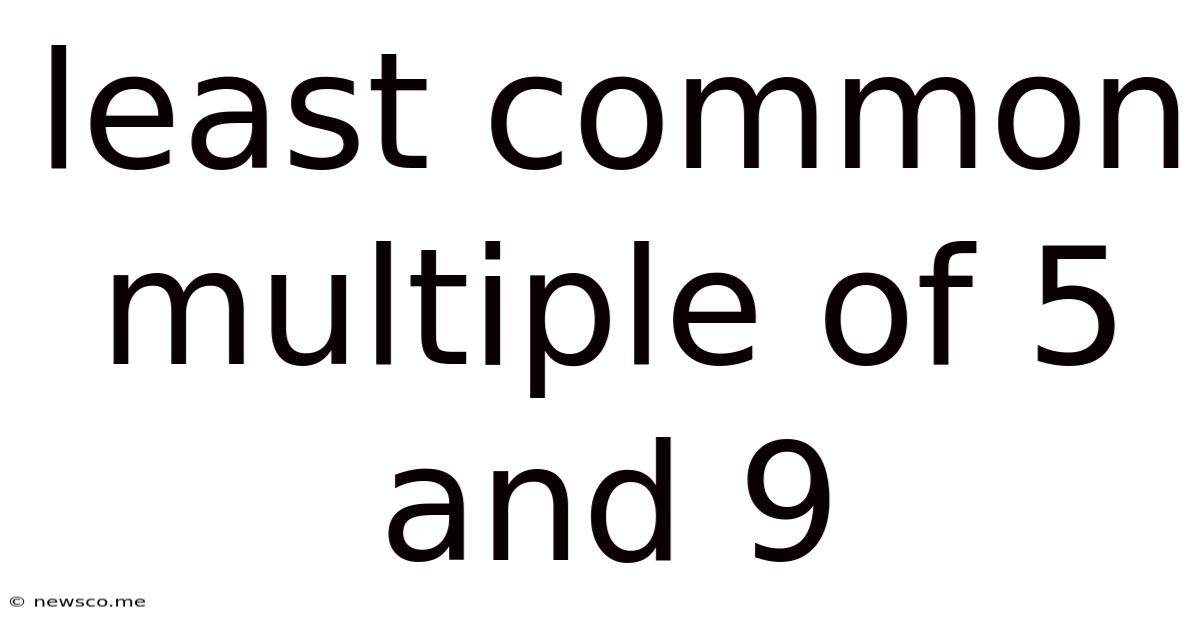Least Common Multiple Of 5 And 9
News Co
Mar 19, 2025 · 5 min read

Table of Contents
Unveiling the Least Common Multiple (LCM) of 5 and 9: A Deep Dive
The concept of the Least Common Multiple (LCM) is a fundamental element in mathematics, particularly within number theory and algebra. Understanding LCMs is crucial for various applications, from simplifying fractions to solving complex equations. This comprehensive article will explore the LCM of 5 and 9, providing a detailed explanation of the concept, multiple methods for calculation, and practical examples to solidify your understanding. We'll also touch upon the broader context of LCMs and their importance in advanced mathematical concepts.
What is the Least Common Multiple (LCM)?
The Least Common Multiple (LCM) of two or more integers is the smallest positive integer that is divisible by all the given integers. In simpler terms, it's the smallest number that contains all the given numbers as its factors. For example, the LCM of 2 and 3 is 6, as 6 is the smallest positive integer divisible by both 2 and 3. This contrasts with the Greatest Common Divisor (GCD), which is the largest integer that divides all the given integers without leaving a remainder.
Finding the LCM of 5 and 9: Multiple Approaches
There are several effective methods to determine the LCM of 5 and 9. We'll examine three common approaches:
1. Listing Multiples Method
This is a straightforward method, especially for smaller numbers. We list the multiples of each number until we find the smallest multiple common to both.
- Multiples of 5: 5, 10, 15, 20, 25, 30, 35, 40, 45, 50...
- Multiples of 9: 9, 18, 27, 36, 45, 54, 63...
By comparing the lists, we observe that the smallest multiple common to both 5 and 9 is 45. Therefore, the LCM(5, 9) = 45.
2. Prime Factorization Method
This method is more efficient for larger numbers and provides a deeper understanding of the underlying mathematical principles. It involves breaking down each number into its prime factors.
- Prime factorization of 5: 5 (5 is a prime number)
- Prime factorization of 9: 3 x 3 = 3²
To find the LCM, we take the highest power of each prime factor present in the factorizations:
- The prime factors are 3 and 5.
- The highest power of 3 is 3².
- The highest power of 5 is 5.
Therefore, LCM(5, 9) = 3² x 5 = 9 x 5 = 45.
3. Formula Method using GCD
This method utilizes the relationship between the LCM and the Greatest Common Divisor (GCD) of two numbers. The formula is:
LCM(a, b) = (|a x b|) / GCD(a, b)
First, we need to find the GCD of 5 and 9. Since 5 is a prime number and 9 is not divisible by 5, the GCD(5, 9) = 1. (Numbers that only share 1 as a common divisor are called relatively prime or coprime).
Now, we can apply the formula:
LCM(5, 9) = (5 x 9) / 1 = 45
This confirms that the LCM of 5 and 9 is indeed 45.
The Significance of LCM in Various Applications
The LCM has far-reaching applications in various mathematical and real-world scenarios:
1. Fraction Addition and Subtraction
When adding or subtracting fractions with different denominators, finding the LCM of the denominators is crucial. The LCM becomes the least common denominator (LCD), allowing for a seamless addition or subtraction process. For example, to add 1/5 and 1/9, we find the LCM of 5 and 9 (which is 45), and then convert the fractions to have a common denominator before adding them.
2. Cyclic Events
The LCM is useful in determining when cyclic events will coincide. Imagine two machines operating on different cycles. One completes a cycle every 5 minutes, and the other every 9 minutes. The LCM(5,9) = 45 indicates that both machines will complete a cycle simultaneously after 45 minutes.
3. Modular Arithmetic and Cryptography
LCM plays a vital role in modular arithmetic, a branch of number theory with significant applications in cryptography. Concepts like the Chinese Remainder Theorem, which is used in various cryptographic systems, rely heavily on LCM calculations.
4. Scheduling and Time Management
In scheduling and time management, LCM helps to coordinate events or tasks that repeat at different intervals.
Beyond the Basics: LCM and Advanced Mathematical Concepts
The concept of LCM extends beyond basic arithmetic and finds application in more advanced mathematical areas:
- Abstract Algebra: The concept of LCM generalizes to other algebraic structures, such as rings and modules.
- Number Theory: LCM is used in several number-theoretic problems and proofs, particularly in relation to prime factorization and divisibility rules.
- Linear Algebra: LCM can indirectly relate to concepts such as finding the least common denominator in matrix operations involving rational numbers.
Conclusion: The LCM(5,9) and Its Wider Implications
This in-depth exploration of the Least Common Multiple of 5 and 9 has demonstrated that the seemingly simple calculation of LCM(5,9) = 45 underpins many crucial mathematical concepts and practical applications. Understanding LCM is not merely an exercise in arithmetic; it is a fundamental building block in various branches of mathematics and plays a significant role in solving real-world problems across diverse fields. By mastering the calculation methods and appreciating its broader significance, you gain a powerful tool for tackling more complex mathematical challenges. The simple case of 5 and 9 provides a perfect entry point into this fascinating and vital mathematical concept. Further exploration into GCD, prime factorization, and other related concepts will solidify your understanding and open up new mathematical horizons.
Latest Posts
Related Post
Thank you for visiting our website which covers about Least Common Multiple Of 5 And 9 . We hope the information provided has been useful to you. Feel free to contact us if you have any questions or need further assistance. See you next time and don't miss to bookmark.